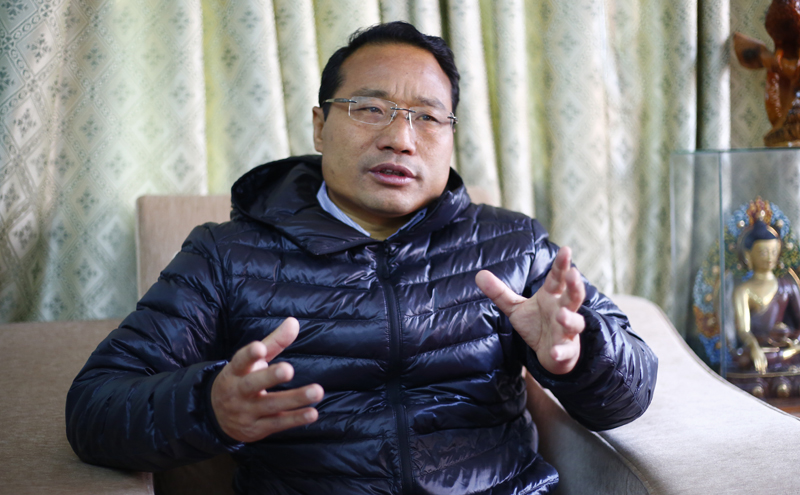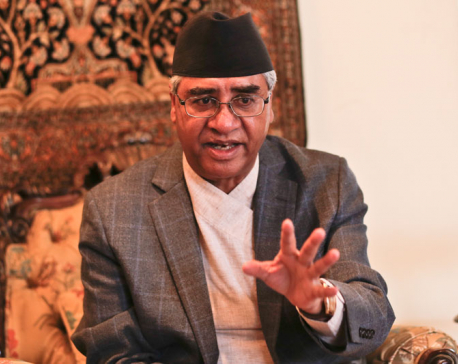
OR
Weekly Interview
All the parties want local elections to test the water
Published On: November 30, 2016 03:00 AM NPT By: Republica | @RepublicaNepal

As we went to press, the ruling coalition had reportedly reached an understanding with the protesting Madheshi parties on the proposed amendments of the new constitution. How did this become possible? What are the points of agreements? And what happens now? Republica team of Biswas Baral and Mahabir Paudyal talked to former finance minister Barsha Man Pun, the Maoist leader who has been a key interlocutor in current negotiations on constitution amendment.
Why did the filing of the amendment motion take so long?
Around 10 percent of the lawmakers had opposed this constitution at the time of its promulgation. The question was: How do we address the sentiments of a section of people who felt left out? This could be done only when we made necessary amendments in the constitution. Only then could it be implemented. So, naturally, the major parties that played a key role in constitution promulgation would have a decisive role in its amendment as well as in its implementation. This is why we were trying to take the major forces into confidence. This took time. Major forces didn’t understand the urgency. At the same time agitating Madheshi Morcha and its constituent parties also failed to understand that all of their demands could not be addressed through amendment. So the process took some time.
Aren’t some constituent parties of Madheshi Morcha still against amendment?
Madheshi Morcha has several demands. But like I said not all of them can be addressed by this government. They know it very well. Our focus now is to make constitution as broadly acceptable as possible by addressing some of their key concerns. Lack of support from Madheshi forces in constitution implementation has already hampered the political process. We have not been able to complete restructuring of local units in eight districts of Province 2. Holding local elections will be the first step towards implementing this constitution. This is why we have told Madheshi Morcha: the government will try to address as many of your concerns as possible through constitution amendment. So you must support it. You can take remaining issues to the people and get them endorsed through popular vote.
How did the Madheshi forces react?
They asked us to address as many of their demands as possible, in which case they promised to support amendment. Indications are they will vote in favor of the proposal and will make remaining issues agendas for upcoming elections. This is a positive response.
The best course for both ruling, opposition and Madheshi parties would be to establish minimal consensus on amendment process, register reservations over the issues that are not sorted out and go to the people with their respective agendas.
There is a lot of confusion over the amendments. Could you clarify?
Amendments have been proposed on fours issues: revision of provincial boundaries, representation in National Assembly, issue of naturalized citizens by marriage and language of official use. Besides, we are proposing powerful terms of reference (ToR) for Federal Commission to settle the number, names and other federalism-related disputes.
As you know, we have been discussing how to sort out the dispute surrounding Jhapa, Morang, Sunsari, Kailali and Kanchanpur for the past one decade. But we have not been able to resolve it. Therefore Federal Commission will resolve this dispute. We have made preparations to move hill districts of Province 5 to Province 4.
What made the ruling parties think of alerting Province 5, especially when there were protests not to do so?
The new proposed model is in line with the ten-province model the Maoist party had floated in the past. Likewise, it is also in line with the seven-province model floated by Nepali Congress and CPN-UML in the second Constituent Assembly. This latter model had put current hill districts of Province 5 in what is Province 4 today. Besides, creating Madhesh province from Nawalparasi to Bardiya will address the concerns of Madheshi and Tharu populations. This is why Province 5 is being altered.
On language, the Language Commission will work on it and submit its report to the government, which will then be included in the annex of the constitution. All languages spoken in Nepal have been proposed as mother tongues. Nepali has been made language of official use. As for other languages, it will be as per the recommendation of Language Commission. As for the representation in National Assembly, the amendment proposal will allocate to each province half the seats based on geography and the remaining half based on population.
What amendments are being made to address the citizenship concerns?
The Constitution of 1990 had a provision that foreign women married to Nepali men would get naturalized citizenship after renouncing the citizenship of their respective countries.
We are going to retain this provision in the constitution. There is no amendment to allow such citizens to occupy top political and constitutional posts, unlike what has been rumored. Thus there was no dispute on citizenship either. The only real dispute was on revision of provincial boundaries.
Again, on state restructuring, how did it become possible to restructure Province 5?
Madheshi Morcha had been demanding two Madhesh-only provinces. Congress and UML had also agreed on a province from Nawalparasi to Bardiya, as did our own Maoist party.
The State Restructuring Committee of CA I had floated a similar proposal as well.
Somehow these proposals got shelved and we had to create Province 5, which no one of us had thought about before. So you can see readjusting Province 5 boundaries as course correction. On Jhapa, Morang, Sunsari and Kailali and Kanchanpur, the debate has lingered for around a decade now. This same dispute led to the dissolution of the first CA. Reviving this dispute could have further delayed constitution amendment and implementation. This is why we decided to assign this task to the future federal commission.
But how do you address the concerns of the people who have been protesting against these amendments in Province 5?
If the people of that province do not accept the amendment proposal, we will have to find ways to address their concerns. But it is too early to talk about it now. Let us first register the proposal and see how people react to it.
There were also demands that every province should incorporate parts of hills, mountains and plains.
Such demands are not in line with the concept of federalism. This basically means that we return to the old five-development region framework. We needed federalism to ensure shared and self-rule of all regions, castes and communities. It was aimed at mainstreaming excluded communities in political system. The demand for hill-plain-mountain components in each province takes us closer to unitary system with decentralization. This will be against the principle of federalism. This is why we should stop looking at federalism through the lens of regional development. Let us stay true to the federal concept when we make decisions.
Isn’t there a constitutional hurdle to altering federal boundary in absence of provincial assemblies?
Those who argue that provincial boundaries cannot be altered by current legislature parliament should understand that transitional provisions guide the state of affairs at the moment. For example, we are yet to make the new Citizenship Act. So citizenship related issues are being handled as per the old Act. In absence of provincial assembly, the sovereign parliament has the power to carry out its functions. Thus you should not interpret transitional provisions as if it were part of a fully-implemented constitution. Until the provincial assemblies come into existence their functions can be carried out by interim parliament. There is no need for confusion on this.
Ruling parties, Madheshi forces and opposition party were poles apart on amendment. How did you find the meeting point?
We were clear that we needed to build minimal consensus over the issues that could be amended and go to the people with our remaining issues. Some provincial disputes, we figured, could be left to the federal commission. There were no differences among parties on amendments on citizenship, representation to National Assembly and language. So this served as a meeting point.
Some believe the government is looking to extend the term of parliament as the chances of holding three elections by January, 2018 are slim.
It would be disastrous to do so. Let us learn from the past. Our attempts to extend the term of the first CA, instead of trying to promulgate the constitution, led to the chamber’s untimely death. Moreover, we could extend the term of the first CA because it was a full-fledged CA. What we have today is an interim parliament. Where in the world has the term of interim legislature been extended? The fact that it is interim means it enjoys legitimacy until new elections are held and federal parliament elected. Thus we should not even think about extending the term of this parliament. We need to do everything possible to come together and hold elections by January 2018 so that the constitution can be adequately implemented. All the parties need to prepare themselves for the same.
In your negotiations have you found political parties ready for elections?
When the proposed amendment bill is passed, the Madheshi Morcha will be ready for local elections. As for the ruling parties and the opposition, there is state of doubt between the two. The government seems to doubt UML is ready for the elections. UML, for its part, seems to believe the government is deliberately delaying elections. But if we can rebuild trust among the parties, there is no reason they can’t together go into elections. After all, local elections will also be an opportunity for the parties to test the water.
You May Like This

One year since local elections, local units still struggling with manpower crunch
RUPANDEHI, Aug 4: One year after the election of local representatives, most of the local units in rural areas are still... Read More...

29 parties register for local elections in Mahottari
MAHOTTARI, March 29: As informed by the District Election Office, Mahottari, only 29 political parties in the district will be able... Read More...

Three parties agree on holding local elections: Deuba
CHITWAN, Dec 15: Nepali Congress President and former Prime Minister Sher Bahadur Deuba has said that the three major political... Read More...

Just In
- Global oil and gold prices surge as Israel retaliates against Iran
- Sajha Yatayat cancels CEO appointment process for lack of candidates
- Govt padlocks Nepal Scouts’ property illegally occupied by NC lawmaker Deepak Khadka
- FWEAN meets with President Paudel to solicit support for women entrepreneurship
- Koshi provincial assembly passes resolution motion calling for special session by majority votes
- Court extends detention of Dipesh Pun after his failure to submit bail amount
- G Motors unveils Skywell Premium Luxury EV SUV with 620 km range
- Speaker Ghimire administers oath of office and Secrecy to JSP lawmaker Khan
















_20240419161455.jpg)
Leave A Comment